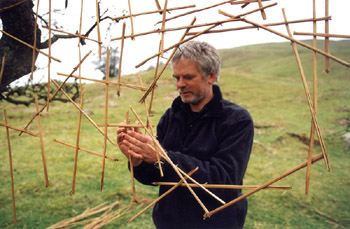![[Metroactive Movies]](/movies/gifs/movies468.gif)
[ Movies Index | Show Times | Silicon Valley | Metroactive Home | Archives ]
Nature's Mercy
The documentary 'Rivers and Tides' adds permanency to Andy Goldsworthy's ever-changing environmental art
By Richard von Busack
WE COMFORT ourselves with the idea of the permanence of art. Against cataclysm, against the ultimate fall of our civilization, we hope that something of the best of our world will survive, in the same way that ruined pieces of marble suggest to us what Rome or Greece was.
Yet much of our most vivid art today is made to vanish. Think of fireworks, poetry readings, tattoos. Think of musicians onstage who send out their energy into the ether, leaving behind only untrustworthy memories of what witnesses thought they heard or saw.
Thomas Riedelsheimer's exquisite documentary Rivers and Tides gives you an hour and a half in the presence of a man in contact with something essential, maybe eternal--yet much of his work is made to fall apart.
Andy Goldsworthy is a British environmental artist, a sculptor of untreated natural materials. In Rivers and Tides, we see the creation of about a year's worth of his pieces. Goldsworthy has done signature work: egg-shaped cairns made from flat pieces of slate, stacked as high and as wide as a man. In the field, however, he uses a wide variety of media: materials as fragile as the heads of flowers, as tender as leaves, as massive as boulders, as doomed as the broken ice from a frozen pond.
With the help of professional "wallers," he builds serpent-shaped stone enclosures around remote sheep farms, with sheep's wool ribboned into the stones. The wool is Goldsworthy's symbol for the muscular power of sheep--most people only see the fluffiness of these animals, he comments. But even these walls will presently be worn away by the ice and the wind.
Early in Rivers and Tides, Goldsworthy completes a squiggle of ice, formed from icicles painstakingly fused together. The same morning sun that lights up his sculpture like neon will also melt it. Working against a persistent breeze, Goldsworthy assembles a fragile mobile of twigs and thorns in a pasture. By the end, he's working with simpler materials yet: clay, red iron pigment suspended in mud. Finally, he's observing the patterns of handfuls of snow scattered in the air. Goldsworthy's photographs are the only record that these pieces existed.
What I'm describing sounds unbearably precious, especially if you prefer film as a stimulant instead of as a hypnotic, and the film provokes slight restlessness, provoked by Fred Frith's New Agey soundtrack. Also, Goldsworthy sometimes seems not just quiet but evasive. There's not much humor in this man's line of work: like a farmer, he labors in all kinds of weather.
Despite these limitations, Rivers and Tides is one of the most dynamic films about a visual artist at work since Henri-Georges Clouzot's The Mystery of Picasso. Still, Goldsworthy is not convivial like Picasso; he doesn't like small talk. He seems most open when he talks to a stranger, a passerby in Nova Scotia who discovers the artist making an intricate hive of driftwood right in the path of the surging tide.
As a subject, Goldsworthy is both open and enigmatic; he talks of how he started as an artist, the local history of the town he lives in. We glimpse him at home between commissioned pieces in Nova Scotia and the sculpture garden at Storm King, New York. Goldsworthy has a family and several children, but his rapport with them is left vague. Are these children trained to leave their father alone when he's contemplating his work? Or is there always a kind of invisible barrier between the artist and his children?
The Internet helped a little. There you can glean such details as the information that Goldsworthy was raised in Yorkshire. Either before or after art school in Bradford, he worked as a farmhand and then moved to his present home in Penpont, Scotland, "due to a way of life over which he did not have complete control." What that means is anyone's guess--again, Riedelsheimer's documentary doesn't press the points.
Like Goldsworthy's art, Rivers and Tides is sturdy yet delicate. It offers some clues to the mystery of Goldsworthy's art, but few clues to the mystery of the man. His art, says the artist, focuses on those things that cause upheaval and shock--the tides, the power of water flowing or freezing. Yet the upheavals and shocks in Goldsworthy's life are mostly between the lines.
Rivers and Tides is worth watching and rewatching as a mystery, then. The element of time--and how an artist works against it--gives Goldsworthy's work tension. This tension keeps Rivers and Tides from being beautiful but dull.
Stone River, an environmental installation, can be seen at Stanford University. Constructed in 2001, the 320-foot-long snakelike stone wall was made from sandstone left over from university buildings crumbled by the 1906 and 1989 earthquakes. The sculpture can be found near the Iris & B. Gerald Cantor Center for Visual Arts on the campus.
[ Silicon Valley | Metroactive Home | Archives ]
Copyright © Metro Publishing Inc. Metroactive is affiliated with the Boulevards Network.
For more information about the San Jose/Silicon Valley area, visit sanjose.com.
![]()

Time-Tested: Artist Andy Goldsworthy's art is destined for destruction.
Rivers and Tides (Unrated; 90 min.), a documentary by Thomas Riedelsheimer, opens Friday at the Towne Theater in San Jose.
Send a letter to the editor about this story
.
From the August 1-7, 2002 issue of Metro, Silicon Valley's Weekly Newspaper.